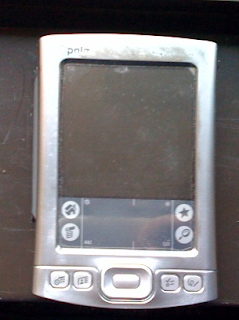I migrated my Calendar by basically stopping use of my Palm/Outlook Calendar and entering data in the iPhone/iCal calendar [1]. I use Spanning Sync to publish to gCal and, less often, update from changes I make to gCal. I'll archive my Palm data in PDFs and data tables.
I migrated tasks by moving them from the Palm to Palm Desktop to archival To Do file to Toodledo. I corrected minor conversion bug on Toodledo and sync with ToDo.app on the iPhone.
I migrated my encrypted password database to 1Password.
Note the above costs money. I've spent about $80 on additional software and services and I'm not done yet. Some of the costs are recurring, but on the other hand so far I've seen no reason to buy MobileMess.
I don't yet know what I'll do with my Memos/Notes. Too bad Google Notebook isn't a more useful product, and too bad Evernote doesn't yet do data freedom. I will probably wait to see if Apple delivers sync of iPhone Notes in September. Other options:
- Put my notes into the Toodledo task framework.
- Use the fake address trick.
- Buy Missing Sync for iPhone.
So the Address Book/Contacts are up next, then I take a break.
I'm expecting to migrate from either Outlook (via Access?) or Palm Desktop to OS X Address Book (10.4 if possible). Options so far:
- Mac OS X 10.1, 10.2: How to import addresses into Address Book
- OS X 10.2 had some import scripts (I suspect these are gone)
- Thunderbird to ldif
- abtransfer
- Sync Address Book with my Palm
- Use Missing Sync for Palm OS - we have an ancient license!
- Buy Missing Sync for iPhone and use the migration assistant to move from the Palm ($25 with a crossgrade from our Missing Sync for Palm and Missing Sync for Blackberry licenses)
- Use MobileMe (added later, I forgot about my prior post!)
[1] As I wrote this note I realized that I could have used my old copy of Missing Sync for Palm and moved the calendar data from my Palm to iCal. Note this exposes one of the many peculiar limitations of iCal. Categories in the Palm become calendars in iCal. Of course Spanning Sync only syncs one calendar to Google. So much for categories ...
Update 8/17/08: Address book moved easily. This is what I did.
- Install my old version of Missing Sync for Palm OS.
- Backup OS X address book and iCal
- Delete all existing Address Book entries and sync iPhone (so all gone from both)
- Disconnect iPhone
- Set Missing Sync to overwrite Notes (might as well get those on the Mac somehow!)
- Disable sync on Everything else including calendar.
- Missing Sync default is to "sync contacts". This is a misnomer on first sync; it should say that handheld will overwrite desktop (same for calendar).
- Consider zipping up your iPhone backup file at this point.
- Sync Palm then disconnect
- Connect iPhone and Sync
Based on what I've learned so far, this is what I'd recommend for any Palm user migrating to iPhone/Mac:
- Consider Missing Sync for iPhone, it includes the "migration assistant" that will move your data. It's $50 new, but you get a $25 sidegrade on other MS products and future upgrades. (See update below however)
- Use Migration Facility to move data from Palm.
- Use iCal data to move tasks to Toodledo or RTM. Pay for these. After migration to Toodledo/RTM, you'll want to delete tasks from iCal and disable task synchronization.
- Buy ToDo.app for iPhone.
- Buy Spanning Sync to sync iCal with gCal (optional).
Update 1/5/09: A commenter left a very negative review of Missing Sync for iPhone, so please read and review before ordering. My experience personal experience was with using other Missing Sync products.
Update 5/7/09: A reader points us to to a detailed migration path from Palm/OS X to iPhone/OS X.



